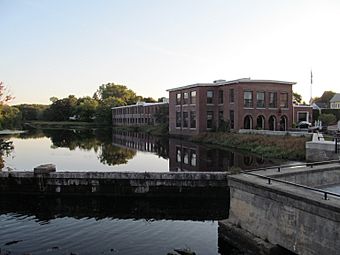Ipswich Mills Historic District facts for kids
Quick facts for kids |
|
|
Ipswich Mills Historic District
|
|

EBSCO Publishing
|
|
| Location | Ipswich, Massachusetts |
|---|---|
| Built | 1868 |
| Architectural style | Greek Revival, Italianate |
| NRHP reference No. | 96000923 |
| Added to NRHP | August 22, 1996 |
The Ipswich Mills Historic District is a special area in Ipswich, Massachusetts. It includes old factories and homes where workers used to live. These buildings are located along the Ipswich River. This area was once a very busy place for making textiles, which are fabrics like cloth.
People have used this spot for mills since the 1600s. In 1868, a company called Ipswich Mill Company bought the land. This company was owned by a rich textile businessman named Amos Adams Lawrence. Over time, more homes for the mill workers were built around the factories. Streets like River Court and Peatfield Street were created. In 1996, the district was added to the National Register of Historic Places. This means it is an important historical site.
Contents
What is the Ipswich Mills Historic District?
The Ipswich Mills district is just south of downtown Ipswich. It sits on the west side of the Ipswich River, near the Choate Bridge. Train tracks and the Ipswich train station are to its west. The northern part of the district held the main factory buildings. The homes for workers were mostly to the south.
The Old Mill Buildings
The factory complex used to be a large group of brick buildings. Most of them were connected. In the 1970s, almost all these buildings were taken down. Only two main buildings remain today.
- The Yarn Mill: This building was built in 1880. It is a four-story brick structure. It has several parts added in the early 1900s. This was a very noticeable building in the factory area.
- The Finishing Building: This two-story building is right next to the river. It was used for the final steps in making textiles. Today, it is separated from the yarn mill by a space that connects two parking lots.
Homes for Mill Workers
Most of the houses in the district were built after the Ipswich Mills started in 1868. One famous house, the John Whipple House, used to be in this area. It was used as housing for mill workers. Later, it was moved to a different part of Ipswich. It is now a National Historic Landmark.
The Ipswich Mill Company built most of the homes in the early 1900s. They built three main types of houses:
- Single-family homes that were 1.5 or 2.5 stories tall.
- Duplexes, which are homes for two families.
These homes were often grouped together on streets like Estes Street and Kimball Street.
History of the Ipswich Mill Company
The Ipswich Mill Company was started in 1868 by Amos Adams Lawrence. This area had been used for different industries since the 1700s. The company made hosiery, which are socks and stockings. Making hosiery was one of the first big industries in Ipswich.
Between 1916 and 1919, the Ipswich Mill Company became the biggest hosiery maker in the world! They had factories in five different places in New England.
The Mill's Decline
After the First World War, people bought fewer of the mill's products. Because of this, the company's factories started to close one by one. The Ipswich mill closed its doors in 1928.
In 1941, a company called Sylvania Electric bought the mill complex. Sylvania Electric was responsible for tearing down many of the old factory buildings in the 1970s.



